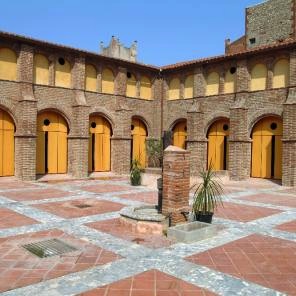Perpignan / Perpinyà la Catalana
Located a few minutes walk from the Castillet, near the Narbonne / Barcelona or Andorra axis, served by city buses nearby the hotel, in a quiet but lively area, the VICTORIA HOTEL no longer counts its many advantages of its location.
Ideally located between sea and mountain, it allows you access to all activities all year long, outings and shows that organizes the municipality downtown.
The access to the sea is almost in a straight line and takes only 10 minutes by car to reach the beach of Canet en Roussillon. All the beaches of the Catalan coast are within reach!
THE CASTILLET

The Castillet, the emblem of the city of Perpignan is the old main gate of the Perpignan precinct. The main body of the building, the great Castillet, built of bricks and marble from Baixas dates back to the Aragonese period. It was built from 1368 and transformed under Louis XI which added to it its current terrace and its brick turret crowned with a dome. The second door, Notre-Dame Gate was built at the same time. In the 17th and 18th centuries the building was transformed into a prison. It currently houses the Museum of History of Catalonia North Joseph Deloncle. 142 steps must be climbed to reach the top of the monument.
Le Palais des Rois de Majorque

Located in the heart of Perpignan overlooking a high promontory, this superb 13th century palace was for almost a century the center of the ephemeral kingdom of Majorca.
This palace was born of the will of James II who wanted a residence in the continental capital of his kingdom. The castle was begun before 1274 in late Romanesque style and completed after 1300 in the Gothic style. The sumptuous chapels indicate the refinement of this period and the status of Perpignan as the economic, political and cultural center of the medieval Mediterranean.
Couvent des minimes

The Minimes, whose order was founded in 1493 by Saint Francis de Paule, built this convent in 1575 on part of the old Jewish quarter. They dedicated the church to Notre-Dame-de-la-Victoire, and in 1617 built a large double-storey cloister built of brick and relatively well preserved.
Military Handling was established there in the 19th century. Since its acquisition by the city at the end of the 20th century, the cloister and choir of the old church, divided in two by a floor, have been restored.
La cathédrale Saint Jean Baptiste

The church of Saint John the Old became too small, the construction of a new building was initiated by Sanç de Mallorca in 1324. The collapse of the kingdom of Majorca stopped the construction site. The original three-aisle plan was abandoned in the 15th century. The Mallorcan Guillem Sagrera, one of the major architects of his time, author of the Cathedral of Palma de Mallorca, opted for a single large nave. The work was completed in 1509. The church was erected as a cathedral in 1602. The facade was adorned with a porch in the 17th century and a wrought iron bell tower in the 18th century.
